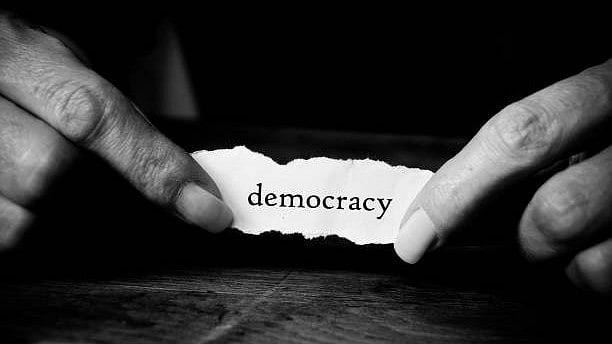
Image for representation.
Credit: iStock Photo
An enduring challenge for liberal democracies is determining how to permit illiberal politics in the name of protecting and defending freedoms — freedoms that could ultimately subvert and destroy both liberalism and democracy. The last century witnessed the rise of illiberal politics: Fascism and Nazism took root in Italy and Germany in the 1920s and 1930s, thriving in democratic systems and coming to power through democratic means.
Once in power, they systematically dismantled democratic institutions, ultimately causing the Holocaust, which killed about six million Jews. It is important to remember that the fascists and the Nazi leaders were primarily responsible for the deadliest war in history — World War II, in which approximately 15 million soldiers and 38 million civilians were killed. Today, blatant dictatorships in the form of fascism or military takeover have largely disappeared. Most countries hold regular elections, yet democracies still die — only by different means. Democratic backsliding today begins at the ballot box.
In their book, How Democracies Die, written two years after Donald Trump assumed power in the US, Steven Levitsky and Daniel Ziblatt outline four behavioural warning signs of authoritarianism: “We should worry when a politician (1) rejects, in words or action, the democratic rules of the game, (2) denies the legitimacy of opponents, (3) tolerates or encourages violence, or (4) indicates willingness to curtail the civil liberties of opponents, including the media.” Alarmingly, Trump met all four criteria. In his 2022 book, The Revenge of Power—How Autocrats are Reinventing Politics for the 21st Century, Moisés Naím, former trade minister of Venezuela, asks what new foe threatens our freedom, prosperity, and even our survival as democratic societies. His answer: “power in malignant form.”
Liberal democracies, shaped by the American and French revolutions of the late 18th century, transformed power relations by making power contestable. With written constitutions, the rule of law, and institutions that ensured checks and balances, power was constrained, accountable, and responsive to the people. Democracy meant lawful competition, regular elections, and a system of checks and balances. But can such democracies withstand aspiring autocrats bent on dismantling these checks, manipulating elections, or refusing to accept the people’s mandate and concede defeat?
Naím terms political leaders who gain power through a reasonably democratic process and then seek to dismantle checks on executive power as “3P autocrats,” who rely on “populism, polarisation, and post-truth.” Lies, fear, and hate become the staples of their political discourse, appealing to emotions rather than facts. Naím’s observes a common pattern: criminalisation of political rivals, using external threats (to promote hyper-nationalism), denigrating experts, attacking free and independent media, and undermining checks and balances.
Populists and demagogues often position themselves as anti-establishment figures, claiming to represent the ‘voice of the people’ while waging war on the corrupt “elite”. They deny the legitimacy of established political parties, the Parliament and the Judiciary, and mock opponents as incompetent, corrupt, undemocratic, and even unpatriotic. The populists revel in breaking unwritten ‘democratic norms’ critical to a healthy democracy. As Naím notes, “The Trump presidency was an institutional slaughterhouse of Washington’s sacred cows.” His most brazen act was inciting his followers to attack the Capitol as Congress prepared to certify the election results.
The Trump presidency polarised American society deeply. In 1960, only 5% of voters said they would be displeased if their child married someone from the opposing party; by 2010, that figure had risen to 50% among Republicans and 30% among Democrats. By 2017, 70% of Democrats reported they could not date a Trump supporter. By 2020, 83% of Trump opponents said they would refuse to date his supporters.
Yet the Trump narrative survived on “post-truth”—blatant lies and falsehood that contradicted mainstream media. As Lee McIntyre notes in Post-Truth, Trump’s “alternative facts” countered the media’s factual reporting, encouraging audiences to reach conclusions that defied evidence. Media fragmentation and the rise of social media fostered an environment in which facts and opinions were presented side by side, leaving the public unsure of what to believe. With the media labelled “the enemy”, Trump bypassed traditional channels, using X (Twitter) then, and now his own Truth Social. One sobering fact is that on his own platform, Trump has less than 7 million followers.
On April 3, 2017, TIME magazine’s cover story asked, ‘Is Truth Dead?’ It was a moment of national reflection on America’s trajectory. During Trump’s campaign, Politfact found that 70% of his statements were false, and nearly two-thirds of voters polled doubted his trustworthiness—yet he won the elections anyway, notes Lee McIntyre.
Predicting what might unfold in America if Trump were to secure another term remains difficult.
(The writer is a former Cabinet Secretariat official)